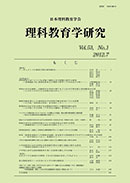Volume 57, Issue 3
Displaying 1-8 of 8 articles from this issue
- |<
- <
- 1
- >
- >|
Original Papers
-
Analysis of Pre-service Elementary Teachers’ Understanding of the Routes of Blood Flows in the Heart2017Volume 57Issue 3 Pages 213-222
Published: March 18, 2017
Released on J-STAGE: April 12, 2017
Download PDF (1002K) -
2017Volume 57Issue 3 Pages 223-232
Published: March 18, 2017
Released on J-STAGE: April 12, 2017
Download PDF (1137K) -
2017Volume 57Issue 3 Pages 233-243
Published: March 18, 2017
Released on J-STAGE: April 12, 2017
Download PDF (1051K) -
2017Volume 57Issue 3 Pages 245-259
Published: March 18, 2017
Released on J-STAGE: April 12, 2017
Download PDF (1045K) -
2017Volume 57Issue 3 Pages 261-271
Published: March 18, 2017
Released on J-STAGE: April 12, 2017
Download PDF (432K)
Note
-
2017Volume 57Issue 3 Pages 273-280
Published: March 18, 2017
Released on J-STAGE: April 12, 2017
Download PDF (323K) -
2017Volume 57Issue 3 Pages 281-291
Published: March 18, 2017
Released on J-STAGE: April 12, 2017
Download PDF (673K) -
2017Volume 57Issue 3 Pages 293-300
Published: March 18, 2017
Released on J-STAGE: April 12, 2017
Download PDF (570K)
- |<
- <
- 1
- >
- >|
